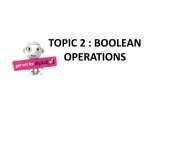Topic 4
You also want an ePaper? Increase the reach of your titles
YUMPU automatically turns print PDFs into web optimized ePapers that Google loves.
TOPIC 4 FLIP FLOP
Flip-flop definition:<br />
•<br />
flip-flop or latch is a circuit that has two<br />
stable states and can be used to store<br />
state information.<br />
•<br />
Flip-flops or latches are used as data storage<br />
elements<br />
•<br />
The circuit can be made to change state<br />
by signals applied to one or more control<br />
inputs and will have one or two outputs.<br />
•<br />
It is the basic storage element<br />
in sequential logic.
•<br />
Data storage<br />
Flip-flop Aplications<br />
•<br />
Timing operation<br />
•<br />
Counting purpose (JK flip-flop and T<br />
flip-flop)<br />
•<br />
Flip-flop (D flip flop) can be used as<br />
frequency divider.
Flip-flop Types<br />
1. SR flip flop:<br />
a) An active HIGH SR Flip-flop<br />
b) An active LOW SR Flip-flop<br />
c) Clocked SR Flip-flop<br />
2. JK flip flop<br />
a) Basic JK Flip-flop<br />
b) JK Flip-flop With PRESET and CLEAR.<br />
3. T flip flop
Introduction of Flip-flops<br />
Triggered<br />
•<br />
The state of a flip-flop is changed by a momentary change<br />
in the input signal.<br />
•<br />
This change is called a trigger and the transition it causes<br />
is said to trigger the flip-flop.<br />
•<br />
The basic circuits of Figure 1 and Figure 2 require an input<br />
trigger defined by a change in signal level.<br />
•<br />
This level must be returned to its initial level before a<br />
second trigger is applied.<br />
•<br />
Clocked flip-flops are triggered by pulses.
Introduction of Flip-flopsTriggered<br />
•<br />
Clock is usually a square wave<br />
•<br />
The clock pulse goes through two signal transitions: from 0 to<br />
1 and the return from 1 to 0. As shown in figure below, the<br />
positive transition is defined as the positive edge and the<br />
negative transition as the negative edge.<br />
Definition of clock pulse transition
Synchronous vs Asynchronous<br />
•<br />
Almost all Logic “Chips” Include a Clock<br />
•<br />
The Clock helps to “Synchronize” the<br />
Operation of the Circuits.<br />
•<br />
The “Clock” is simply a very regular Hi/Lo<br />
Pulse train <br />
•<br />
Logic Forms are divided into two groups:<br />
– SYNCHRONUS → Depend on Clock<br />
– Asynchronous → NO Clock-Dependency
An Active HIGH SR Flip-flop<br />
• Logic symbol:<br />
• Logic circuit:<br />
S<br />
R<br />
Q<br />
Q<br />
'
§ Truth table for active-high input S-R flip-flop:<br />
§ Timing diagram:
An Active LOW SR Flip-flop<br />
• Logic symbol:<br />
S<br />
R<br />
Q<br />
Q'<br />
• Logic circuit:
§ Truth table for active-low input S'-R' flip-flop:<br />
S' R' Q Q' Condition<br />
0 0 1 1 Invalid condition.<br />
0 1 1 0 SET<br />
1 0 0 1 RESET<br />
1 1<br />
Q Q' Hold<br />
§ Timing diagram:
Clocked SR Flip-flop
Logic circuit for Clocked SR Flip-flop
Timing diagram for positive edge<br />
triggered
Example of waveform positive<br />
edge triggered
Example of waveform negative<br />
edge triggered
Timing diagram for negative edge<br />
triggered
JK Flip-flop<br />
•<br />
The sequential operation of JK flip-flop is<br />
exactly same to the SR flip-flop.<br />
•<br />
The difference is JK flip-flop has no INVALID<br />
input state but using a TOGGLE operation.<br />
Figure: Logic circuit of JK Flipflop
JK Flip-flop<br />
• Logic symbol:<br />
•<br />
Truth table:<br />
Change to
Figure: Timing Diagram for JK FF<br />
using Positive edge triggered with<br />
Q initial is 1<br />
JK Flip-flop<br />
•<br />
Timing diagram/waveform (example):
JK Flip-flop<br />
(with Synchronous and Asynchronous Input)<br />
•<br />
JK FF have 2 outputs and 5 inputs<br />
•<br />
Synchronous input : J, K and CLK<br />
• Asynchronous Logic input : Preset (PRE) and Clear<br />
(CLR) symbol:<br />
•<br />
Output : Q and Q’.
JK Flip-flop<br />
(with Synchronous and Asynchronous Input)<br />
•<br />
Asynchronous inputs on a flip-flop have<br />
control over the outputs (Q and not-Q)<br />
regardless of clock input status.<br />
•<br />
The preset (PRE) input drives the flip-flop to a<br />
set state while the clear (CLR) input drives it to<br />
a reset state.<br />
•<br />
It is possible to drive the outputs of a J-K flipflop<br />
to an invalid condition using the<br />
asynchronous inputs, because all feedback<br />
within the multivibrator circuit is overridden.
JK Flip-flop<br />
(with Synchronous and Asynchronous Input)<br />
Figure: JK Flip-flop with PRE and<br />
CLR truth table
Timing Diagram For JK Flip-flop<br />
(with Synchronous and Asynchronous Input)
Timing Diagram For JK Flip-flop<br />
(with Synchronous and Asynchronous Input)
T Flip-flop<br />
•<br />
This flip-flop toggles (Q changes state)<br />
on the negative going edge of the<br />
clock pulse.<br />
•<br />
Q will only toggle on the negative edge<br />
of the clock pulse, when T is high.<br />
Logic symbol<br />
(Positive edge<br />
triggered)<br />
Logic symbol<br />
(Negative edge<br />
triggered)
•<br />
Logic circuit:<br />
T Flip-flop
T Flip-flop<br />
•<br />
Truth table :<br />
• Timing<br />
diagram :<br />
Assume that Q0 =<br />
1
Truth<br />
table<br />
D Flip-flop<br />
•<br />
The D stands for "data".<br />
•<br />
The D type flip-flop has only one input (D<br />
apart from the clock)<br />
Logic symbol<br />
(Positive edge<br />
triggered)<br />
Logic symbol<br />
(Negative edge<br />
triggered)
•<br />
Logic diagram<br />
D Flip-flop
D Flip-flop<br />
•<br />
When the clock goes high, D (a 0 or a 1) is<br />
transferred to Q.<br />
• When Timing the clock goes low, Q remains<br />
unchanged. diagram :<br />
At A, clock and data are high.<br />
Q goes high and stays high until<br />
•<br />
Q stores the data until the clock B. goes high<br />
again, when new data may be low. available.<br />
At B, clock is high and data is<br />
Q goes low and stays low until<br />
C.
Construct a D Flip-Flop Using JK Flip-Flop<br />
•<br />
D flip-flop can be constructed using JK flip-flop<br />
If the input of J and K are connected to<br />
the inverter.
Construct a T Flip-Flop Using JK Flip-Flop<br />
• T flip-flop can be constructed using JK flipflops<br />
by connecting both inputs J and K<br />
together.<br />
CLK<br />
T<br />
J<br />
clk<br />
K<br />
Q<br />
Q'







